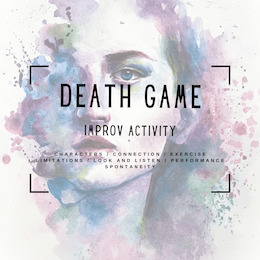Toolbox — For Training and Youth Work
All new tools in your inbox: Be the first to know about new tools for learning with our e-mail notifications.
Simulation Exercise, Exercise, Ice-breaker, Group Building Activity
Death Game (Improv Game)
This is an Improv exercise/game to boost spontaneity, creativity and connection.
Aims of the tool
• to boost spontaneity;
• to boost creativity;
• to boost connection (team-building).
Description of the tool
The game is composed of several rounds (we usually play 4 rounds). The participants are being mixed in several small groups (3-5 people in one group is the optimal quantity). Each round each group is secretly picking the papers with different topics/situations for a scene to play (e.g., “Ship”, “Castle”, “Restaurant”, etc.). Each round the time for the scene preparation is being reduced up to 0 seconds for preparations and discussions in the last round (e.g., we can have 4 rounds with 3 min – 1,5 min – 30 sec – 0 sec for preparations and discussions). The task for the groups is to play the scenes on the picked topics with the main condition that at least 1 character has to be "dead" in the end of each scene. During the play it is not allowed to talk, however, the actors may use any sounds. It is highly encouraged to make the scene logical and clear. After each scene there is a feedback from the audience with the core questions to be answered: “What is the topic of the scene?”, “Where is the action happening?” and “What has happened?”.
Then another group is playing their scene. After all the groups have played in the 1st round, the 2nd and then the 3rd rounds are coming (new topics are being picked, new reduced time limit for preparation is being set, new scenes are being shown, feedback from the audience and from the acting groups is being done).
When it comes to the last 4th round, we have a bit different rules. Now we have 0 seconds for preparations and discussions, which means we’re starting from the 0 point and have to start acting right after taking the paper and looking on what’s written there. To avoid any preparations and make the game absolutely spontaneous, the only one group at once now is coming out on the stage and taking the paper with the topic. The tricky thing here is that for this round there’s just an empty paper without any topic when you unfold it (therefore, it is a good idea to give the instruction for the groups in advance “whatever you see on the paper is correct, don’t be surprised, just start acting!”). After that smd has to immediately start acting smth and the rest of the participants in the group has to understand, where the proposed initial action takes place, support the play, in the process adjusting to each other and then follow the basic rules where at least 1 character has to be "dead" in the end of the scene and all the scene itself should be logical and clear. Then we have feedback from the audience. And after that the next group comes out on the stage, until every group accomplishes the 4th round play.
The reflection.
Disclaimer
SALTO cannot be held responsible for the inappropriate use of these training tools. Always adapt training tools to your aims, context, target group and to your own skills! These tools have been used in a variety of formats and situations. Please notify SALTO should you know about the origin of or copyright on this tool.
Tool overview

http://toolbox.salto-youth.net/3121
This tool addresses
Group Dynamics, Personal Development, Youth Participation
It is recommended for use in:
Youth Exchanges
Training and Networking
Materials needed:
the papers with various random locations/topics for all the groups and rounds
Duration:
30-60 minutes (depending on the number of the playing groups)
Behind the tool
The tool was created by
Vladimir Kozachun
The tool was published to the Toolbox by
Vladimir Kozachun (on 11 February 2022)
and last modified
10 January 2022
Comments
No comments have been posted yet.
If you want to comment on this tool, you need to be signed in with your MySALTO account. Sign in now